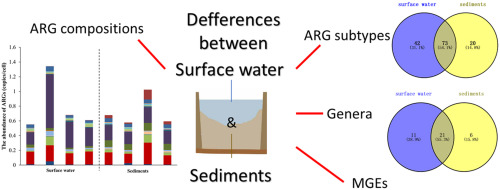Ecotoxicology and Environmental Safety ( IF 6.8 ) Pub Date : 2018-05-30 , DOI: 10.1016/j.ecoenv.2018.05.044 Haoyu Jiang , Renjun Zhou , Mengdi Zhang , Zhineng Cheng , Jun Li , Gan Zhang , Baowei Chen , Shichun Zou , Ying Yang

|
To better understand the potential genic communication and dissemination of antibiotic resistance genes (ARGs) in different environmental matrices, the differences of ARG profiles between river surface water and sediments were explored. Metagenomic analysis was applied to investigate the comprehensive ARG profiles in water and sediment samples collected from the highly human-impacted catchment of the Beijiang River and its river source. A total of 135 ARG subtypes belonging to 18 ARG types were identified. Generally, ARGs in surface water were more diverse and abundant than those in sediments. ARG profiles in the surface water and sediment samples were distinct from each other, but some ARGs were shared by the surface water and sediments. Results revealed that multidrug and bacitracin resistance genes were the predominant ARGs types in both surface water (0.30, 0.17 copies/cell) and sediments (0.19, 0.15 copies/cell). 73 ARG subtypes were shared by the water and sediment samples and had taken over 90% of the total detected ARG abundance. Most of the shared ARGs are resistant to the clinically relevant antibiotics. Furthermore, significant correlations between the ARGs and 21 shared genera or mobile genetic elements (MGEs) (plasmids and integrons) were found in surface water and sediments, suggesting the important role of genera or MGEs in shaping ARGs profiles, propagation and distribution. These findings provide deeper insight into mitigating the propagation of ARGs and the associated risks to public health.
中文翻译:

用宏基因组学方法研究河面水和沉积物之间的抗生素抗性基因谱的差异
为了更好地了解不同环境基质中抗生素抗性基因(ARGs)的潜在基因交流和传播,探索了河面水和沉积物之间的ARG谱的差异。应用元基因组学方法研究了北江及其河流水源高度受人类影响的集水区收集的水和沉积物样品中的综合ARG谱。共鉴定出属于18种ARG类型的135种ARG亚型。通常,地表水中的ARGs比沉积物中的ARGs更加多样化和丰富。地表水和沉积物样品中的ARG轮廓彼此不同,但一些ARGs被地表水和沉积物共享。结果表明,在地表水(0.30,0.17拷贝/细胞)和沉积物(0.19,0.15拷贝/细胞)中,多药和杆菌肽耐药基因是主要的ARGs类型。水和沉积物样品共有73种ARG亚型,占了检测到的ARG丰度总量的90%以上。大多数共享的ARG对临床相关抗生素具有耐药性。此外,在地表水和沉积物中发现了ARGs与21个共有属或活动遗传元件(质粒和整形体)之间的显着相关性,表明该属或MGEs在塑造ARGs的轮廓,繁殖和分布方面具有重要作用。这些发现为减轻ARG的传播以及对公共健康的相关风险提供了更深刻的见解。水和沉积物样品共有73种ARG亚型,占了检测到的ARG丰度总量的90%以上。大多数共享的ARG对临床相关抗生素具有耐药性。此外,在地表水和沉积物中发现了ARGs与21个共有属或活动遗传元件(质粒和整形体)之间的显着相关性,表明该属或MGEs在塑造ARGs的轮廓,繁殖和分布方面具有重要作用。这些发现为减轻ARG的传播以及对公共健康的相关风险提供了更深刻的见解。水和沉积物样品共有73种ARG亚型,占了检测到的ARG丰度总量的90%以上。大多数共享的ARG对临床相关抗生素具有耐药性。此外,在地表水和沉积物中发现了ARGs与21个共有属或活动遗传元件(质粒和整形体)之间的显着相关性,表明该属或MGEs在塑造ARGs的轮廓,繁殖和分布方面具有重要作用。这些发现为减轻ARG的传播以及对公共健康的相关风险提供了更深刻的见解。在地表水和沉积物中发现了ARG与21个共有属或活动遗传元件(质粒和整形体)之间的显着相关性,表明该属或MGE在塑造ARG的轮廓,繁殖和分布方面具有重要作用。这些发现为减轻ARG的传播以及对公共健康的相关风险提供了更深刻的见解。在地表水和沉积物中发现了ARG与21个共有属或活动遗传元件(质粒和整形体)之间的显着相关性,表明该属或MGE在塑造ARG的轮廓,繁殖和分布方面具有重要作用。这些发现为减轻ARG的传播以及对公共健康的相关风险提供了更深刻的见解。



























 京公网安备 11010802027423号
京公网安备 11010802027423号